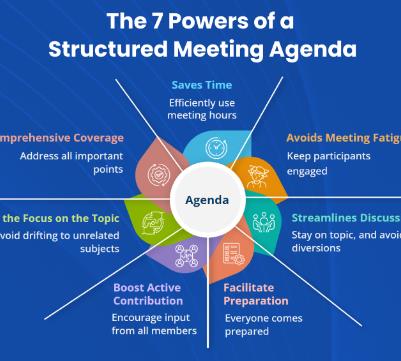What Are Key Elements of a Good Agenda?
Crafting a Purpose-Driven Meeting Agenda
A well-crafted agenda is crucial for any successful meeting. It acts as a blueprint for the discussion, ensuring that the meeting is focused, efficient, and productive. Whether for a team briefing, a project update, or a strategic planning session, the structure of the agenda can dramatically influence the outcome of the meeting. Here, we delve into the essential components that make an agenda effective.

Clarity in Objectives
Define Clear Goals: Every agenda should start with a clear statement of the meeting’s objectives. This focuses the discussion and ensures that every participant understands the purpose of the gathering. For instance, stating, "The goal of this meeting is to finalize the Q4 marketing strategies," sets a specific direction for the attendees.
Detailed Schedule and Timing
Time Allocation: Assign specific times to each agenda item. This practice helps in managing meeting length, which should ideally not exceed 60 minutes as attention spans tend to wane after this point. For example, allocate 15 minutes to discuss each major agenda point. Studies show that meetings planned with strict time allocations are up to 40% more efficient.
List of Topics in Order of Priority
Prioritize Discussion Points: Structure the agenda items from most to least critical. This ensures that the most important decisions are tackled when participants are most alert. Practical application involves starting with strategic items like budget approvals before moving on to less critical operational updates.
Participant Roles and Responsibilities
Specify Roles: Clearly indicate who is responsible for leading each part of the discussion. This not only prepares the speakers but also informs participants of what to expect and who to direct questions to during the meeting.
Preparation Requirements
Pre-meeting Work: If the discussion requires participants to review documents, perform analyses, or prepare reports, list these requirements explicitly in the agenda. This ensures everyone comes prepared, which significantly enhances the productivity of the meeting.
Flexibility for Unforeseen Issues
Buffer Time: Include a short segment dedicated to additional concerns or unexpected topics that may arise during the meeting. This buffer helps to manage time effectively without neglecting spontaneous but relevant discussions.
Closing and Action Items
Define Next Steps: End every meeting with a clear outline of action items, assigned responsibilities, and deadlines. This section is vital as it ensures that decisions lead to actions, and it holds people accountable.
Enhancing Agenda Effectiveness with Technology
Use of Tools: Leverage meeting management tools to create, distribute, and update agendas. These tools can also archive past meeting agendas and outcomes for reference, which improves continuity and accountability.
Real-World Impact
In practice, consider a scenario where a tech startup uses the agenda to streamline their weekly product development meetings. By setting clear objectives, specifying roles, and clearly defining action items with deadlines, the team can accelerate product enhancements and resolve issues more efficiently.
The Path to Productive Meetings
Recognizing that the key elements of a good agenda include clear objectives, detailed schedules, prioritized topics, defined participant roles, preparation requirements, and flexibility for additional discussions can transform an ordinary meeting into a powerful tool for decision-making and team alignment. With these elements in place, meetings become a catalyst for action and a cornerstone of organizational success.
